The Making of Super Dassalo Land
INTRODUCTION
Since Super Dassalo Lands release three weeks ago, the amount of positive feedback that Tommy and I have received has been immense. We have had the odd interview here and there thanks to the buzz generated on itch.io and Tommy's natural ability to perform for an audience on YouTube. Because I am neurodiverse, I have elected not to do recorded interviews but as many GB Studio Central readers are aware, I write about my own design process and analyze licensed Game Boy games often.
Some players and GB Studio devs have reached out and asked questions about the development of SDL, so I thought I would write a 'making of' devlog and share some of the process with fans of the game by extrapolating on some interview answers I have given to Sifter and Johndo TV. This will be a long one, so I have split the write-up into more manageable chapters, in case you want to read this in multiple sittings.
1. How Super Dassalo Land came about
2. SDLs Development Team
3. Working on a Game Linked to a Comedy Special
4. Challenges and Overcoming Them
5. The Collaborative Process
Please note that this devlog contains spoilers, so make sure you play the game before continuing.
1. How Super Dassalo Land came about
I was the game designer, level designer, artist and team manager for McDonalds ‘Grimace's Birthday’ promotional GBC game that was part of the Grimace's Milkshake ad campaign of 2023. Tommy had played that and decided to contact me via instagram to discuss making a promotional game for his then unreleased stand-up comedy special ‘Scam Artist’.
Tommy assumed I was American. The fact that we both live in the same city was a happy coincidence. What's even more coincidental is that one of my closest friends and best man of my wedding was school buddies with Tommy back in the 90s and they would play Goldeneye on the N64 together. Small world, indeed!
Anyway, he came to me and we discussed the possibilities of a platformer GBC game that would act as a prequel to his special. Originally, we explored what I called a 'reverse gated exploration' concept (think Metroid but you lose your abilities instead of gain them over time), in which Tommy would start with a bunch of powers and would slowly lose them through scripted looney toons-esque violent events as he made his way to the recording of his stand-up special until he would eventually, he would crawl onto the stage by the end credits. It's a funny concept and one that would be unique amongst short-form platformers out in the wild. But the major issue with a reverse gated exploration game is that it gets less complex over time, which would make it more difficult to maintain a players engagement over a thirty minute experience. The idea could potentially work as a comedy game that lasted five to ten minutes minutes, but if we wanted to make something longer, my gut was telling me we needed to put a pin in this concept and move onto something else.
Luckily, Tommy had his own idea waiting in the wings. He wanted a story line in which he and his dog Kewpie would get sucked into his notebook by an evil spirit and the player would have to rebuild joke routines in order to escape back to the real world. The central mechanic he offered was for the player to find items in each level that would build a comedy routine at the end of world, allowing the player to progress to the next world. It was something we could hang all the platformer mechanics on and create a through-line that would take the player through a game neatly, and so we were able to move on to the nitty gritty of level and game design from there.
2. SDLs Development Team
I work on something every day, often putting in 10 hours a day. That is the main reason why my output is quite large. Another reason is I have ADHD and autism so I tend to get very fixated on my projects. This is great in terms of the sheer volume of self expression I get to explore, but it can also lead to unsustainable self-inflicted periods of crunch that sometimes cause mental health issues. Whats more, many of my ideas also go beyond my own skill ceiling and so I find it best to collaborate with more experienced and knowledgeable coders in order to attain my goals.
In the case of SDL, we initially planned on making a much smaller game, something with three to five levels and a handful of cutscenes. We had to be mindful of production costs and scope - Tommy is not McDonalds! But we both tend to get carried away when being creative I think, so the games scope kept expanding and becoming more ambitious over time.
Related to this budget pressure but as an aside, I thought I'd share a short story about the initial development while I'm on the subject. Tommy is obsessed with his dog Kewpie (as you can probably tell if you have played SDL). Initially, Tommy asked me to include Kewpie as a companion that the player could ride around on as a kind of power-up. If you're not aware, including something like this in a Game Boy platformer is somewhat of a tall-order. There is limited space for sprites that can be stored in the Game Boys RAM, and something large such as Tommy sitting on Kewpie that may or may not be used in a level was something I felt would hinder the overall experience by inhibiting the amount of enemies or sprite based mechanics I could put in any one level. It may have been possible and with a lot of careful planning and sprite optimization, its certainly possible to include something like this... but in those early days, when I was so careful about blowing Tommy's budget, it felt like a considerable risk.
So despite Tommy's desperation, I said its just not a good idea as much as that would be fun. Instead, I suggested we put Kewpie at the end of the levels to create a check that forced players to collect the comedy routine special item in each level - something I would need to solve anyway.

A segment from the Introductory Cut Scene in SDL
Later on, when Tommy shared his introductory cut scene script, I saw he had made made a joke out of the Kewpie companion mechanic I had so emphatically knocked back. Well, I couldn't let him have the last laugh there, so I started thinking more deeply about how I could insert a ride-able Kewpie into the game.
Then it dawned on me... what if we shift to a shmup style boss fight at the end, just like in Super Mario Land? You can easily pour more sprites into a player character with something like a shmup because the "ship" doesn't need anywhere near as many sprites as a platformer player character! So that's what I proposed, and this joke on me and my refusal to give Tommy the ability to ride his dog turned into a setup for a great moment where Kewpie has a chance to save the day at the end!
As you can tell, I was very much enjoying working with Tommy and SDL was fast becoming not just a commission, but a joyful project I would work on for fun. So eventually, I thought it best to bring in the likes of Bryan Taylor (who I worked with to produce IN THE DARK 2) and Emi Paternostro (who is the Managing Editor of GB Studio Central) to help me code, and realized we could make the experience even better if I started putting in hours free of charge here and there. With this choice, we could then use a portion of the budget to pay for programmers that could push some of the mechanics further. Importantly, with more expert coders polishing and debugging the code, I would also be able to spend more time on the art and game and level design which would in turn reduce my own stress levels throughout the project as coding can sometimes be very difficult for me with my neurodivergent brain. In any case, less stress for me and a better game for Tommy and its players is a no-brainer!
Next, we enlisted Sloopygoop to create the soundtrack. Tommy (and I) are massive fans of the Wario Land series, and much of the games inspiration comes from Wario Land. Sloopy is no stranger to making Wario style chiptunes, and his compositions for the game really elevated the experience. When I added Sloopy's first tracks to the game, it was at that moment that Tommy felt Super Dassalo Land had really come into its own.
3. Working on a Game Linked to a Comedy Special
In some ways making SDL was made easier by being able to draw off an existing piece of media. I could watch Tommys special ‘Scam Artist’ and start mining it for ideas. For instance, the first shmup level (3-3) uses some of the characters Tommy created for the special as enemies. Specifically, the Podcaster Character is contractually obligated to advertise ball buzzers to Tommy in the show, and I used them to inform the various attack patterns used in the game. So a few different buzzers became enemy projectiles thrown by the Podcaster Mini-boss - all I had to do was design the behaviors of the ball buzzers.

The Podcaster Character featured in ‘Scam Artist’ by Tommy Dassalo
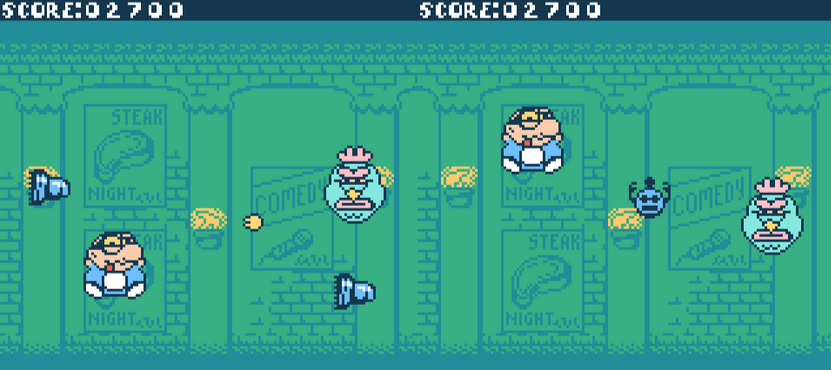
The Podcaster Enemy and his Projectiles in Super Dassalo Land
On the other hand, because the game is so closely linked to the special, you have to be mindful the game's direction doesn't depart stylistically and tonally from the primary goal - to act as a prequel and companion piece to 'Scam Artist' and to celebrate the rich history of the Game Boy era. So not all creative choices will be the right fit. That being said, Tommy was very open to exploring my own ideas. I was interested in including homages to great games from the Nintendo library. Tommy was more than okay with suggestions like including a shmup section reminiscent of Super Mario Lands boss battles or a final map based on Wily Castle from the Mega Man series. Likewise, I was more than happy to homage Wario Land 4 with Tommy's request to include himself and Kewpie driving to the recording of 'Scam Artist' in Wario's car.
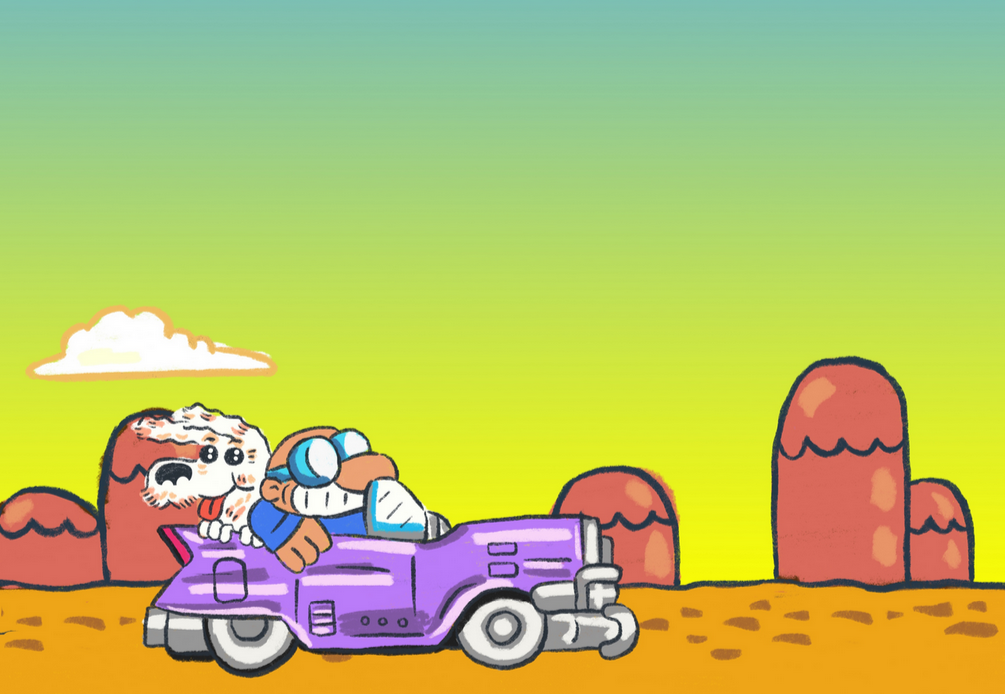
Credits Sequence Mock-up by Tommy Dassalo
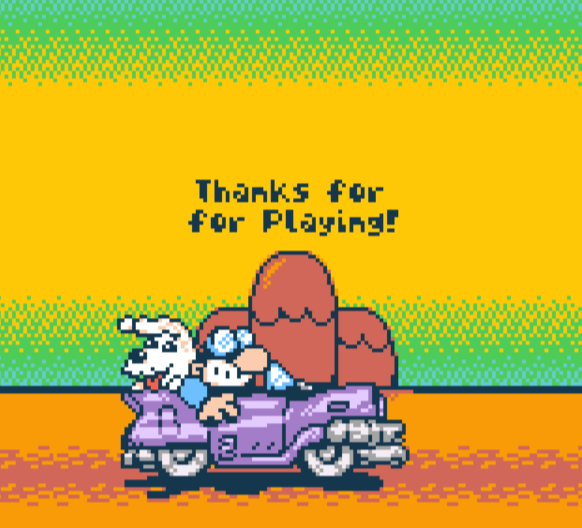
Credits Sequence Final
Ultimately, I wanted Tommy to have the final say when it came to the larger picture. I would offer ideas and change details when I saw an opportunity to improve the player experience in a game design sense, but I was eager to have Tommy's personality shine and careful not to insert my own personality into the game when it could overshadow or run counter to Tommy's vision.
For example, Tommy had this great idea that Jiko, the games antagonist, would end up being the embodiment of his own self doubt. I just adore this idea, as its obviously a common (and very serious) problem for any creative person. To me, it elevates what only needed to be a promotional tool, into something far more artistically provocative. Now the player wouldn't just be defeating a spirit that had locked them inside Tommy's notebook. The player would be confronting a dark-side of Tommy's inner creative turmoil and directly helping Tommy to overcome his demons, get up on stage and perform a killer show.
I suggested that Jiko's phase 2 fight could have the boss turn into a giant "evil" Tommy head. Something akin to Konami's bosses in Gradius, Salamander and the Parodius series, or perhaps Andross in Starfox 64 (Lylat Wars here in Australia). The player would need to destroy Evil Tommy's glasses and then go for his eyes and Evil Tommy would retaliate with attacks coming out of his mouth and nostrils or from below.

The Brain Golem from Konami's Gradius and Salamander series (Left), Andross from Starfox 64 (Middle) and the Maoi Head from Parodius (Right)
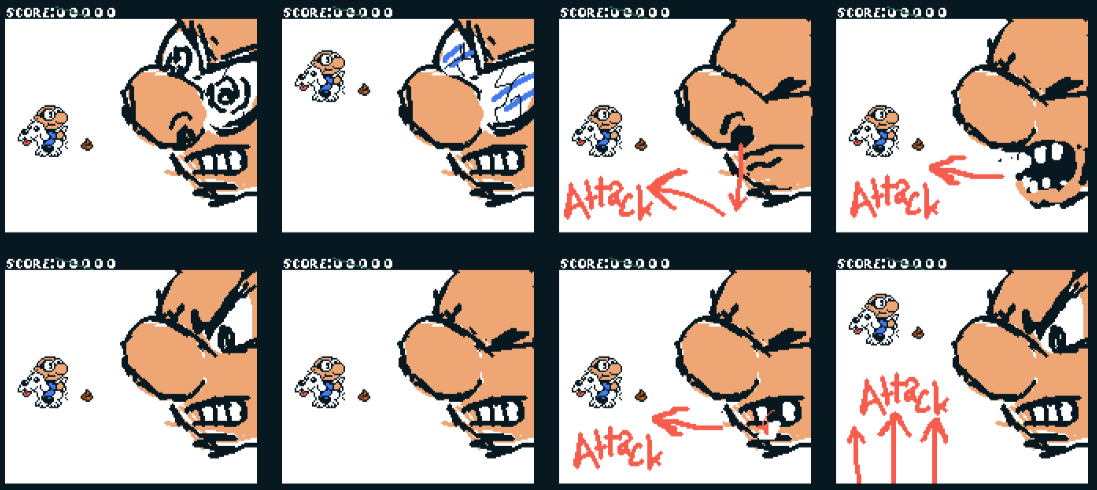
A mock-up of a potential final boss fight I shared with Tommy, open ended enough to allow Tommy to skin Evil Tommy and his attack patterns any way he wanted.
But Tommy then shared his own idea. One that brilliantly made homage to the Koopa Clown Car from the Mario series - a perfect fit for a vehicle used by a boss created in the image of a comedians self-doubt. He even got the ball rolling on some possible attack patterns. I loved the idea of Jiko summoning various attacks by pulling out a piece of paper and sketching something on it and it all just fit so nicely, so I got to designing what is now in the game.

Jiko Phase 2 Mock-up by Tommy Dassalo, complete with sketches of possible attacks
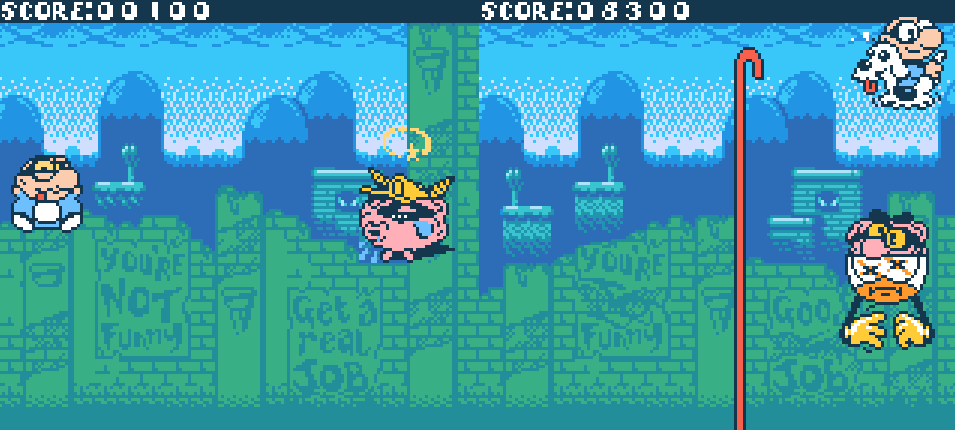
Jiko phase 1 fight (left) and phase 2 (right) Final
I think Tommy's version of the final boss came out really well in the end. If you pay close attention to the posters in the background, you can see they hint at Tommy over coming self-doubt as the fight progresses. "You're not funny" and "Get a real job" become "You're funny" and "Good job" when the walls begin to crumble and the posters rip. In Tommy's own 'Filthy Casuals', a podcast where three comedians (Tommy, Ben Vernel and Adam Knox) discuss video games, they mention being told to "get a real job". Being an indie developer, I have also had that experience, so I felt compelled to put this little detail in given the opportunity.
4. Challenges and Overcoming Them
Just as with Grimace’s Birthday, Super Dassalo Land is designed to promote something that is not directly games related. As a result, many of the potential players of SDL may not be all that familiar with games, and some may have never played a platformer before. On the other hand, some players will be platformer aficionados, too. So the challenge with a project such as this, is to make a game that caters to two very different target audiences at the same time.
The first is the non-gamer who happens to be a fan of “Bald Heart-throb Comedian Tommy Dassalo” and wants to try out a small game that accompanies his stand-up special. In this case, my job is to provide something that is very forgiving of player mistakes so it's reasonably easy to make it through to the end. This way, they can enjoy the jokes, the art and the ride until they reach the credits. For this reason, Super Dassalo Land features no health points and each level is quite short in length. The only way to die is to time out or to fall in a pit. The player will get knocked back if they get hit by an enemy or a projectile but the invincibility frames that follow last for a very long time - long enough to pass by the direct threat. The player also has a constant horizontal speed. There is no option to sprint like you would in a Mario game. It's much more in step with the Wario titles in that regard. Furthermore, much of the more complex player moves such as the dash and especially the jump out of the dash are not required to finish the game. As long as the player can hold right and get the hang of jumping, they will likely see the end credits.
The second is the retro style gaming fan who is probably a seasoned platformer expert and is looking for a fun Game Boy Color homebrew game they can pick up and play for an hour and be engaged by it. For this audience I added all the extra optional mechanics. This includes a large player move-set, optional collectibles that require mastery of the moves to collect them all and most importantly, a ranking system that can test the skills of a player on subsequent runs. The player can then check their stat's and compete with their friends in a score attack, or a time attack speed run.

The Final Totals Screen (my dev scores posted on my Instagram Account)
But the most challenging aspect of this project is by far designing a platformer that will be played using touch controls on a phone!
From the outset, we were always going to release a Game Boy Color ROM of Super Dassalo Land so players could enjoy the game on real hardware, but we also knew that many people were going to be playing this game in browser via itch.io and for those using their phone, they would have to attempt to play using the touchscreen controls of a Game Boy button configuration. And using touch controls to play a platformer SUCKS!
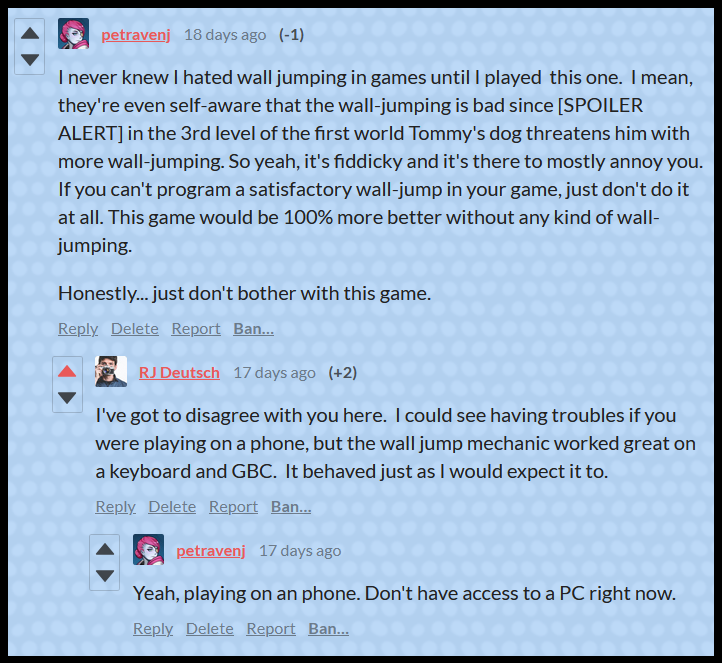
See, playing a platformer with touch controls is horrible!
Thankfully, many of the design choices implemented to avoid frustration for non-gamers also helped to relieve the problems of using touch controls to play Super Dassalo Land. Getting the balance right between a platformer with a player move-set that’s engaging to Tommy and gamers that share a similar passion for the 2D platformer genre versus a game simple enough for the average player to enjoy with touch screen controls isn’t going to be perfect, of course. I must admit, in some cases I prioritized players using hardware when it came to level design (especially 1-3’s wall jump heavy level). But that's okay... In the end, the people that will be returning to get the most out of a speedrun or a score attack will be those that want to play using button controls.
5. The Collaborative Process
From the very beginning, Tommy was providing art direction. As you can see in ‘Scam Artist’, Tommy is an artist and animator himself, so he would provide mock ups of the worlds we would be creating as well as screens for the numerous cutscenes. I was delighted to work with him for this reason.
Tommy had some great ideas for world biomes. Ramen Springs, Scrolling Skies and Blackout HQ are all unique and memorable in their own way. He would illustrate a plan of Ramen Springs for example, complete with many of the elements I would need to get started on a tileset. I’d ask him to include something for a solid collision, or a one way platform, and he would make sure there was something in there that I could use as a mechanical element when designing levels. And I was free to edit elements here and there if the level design required it or to improve readability.

Ramen Springs Mock-up by Tommy Dassalo

Ramen Springs 1-1 final
It’s a welcome change when the client can hand you exactly what they see in their head, fully realized and painted in the precise color scheme they want and that color scheme also reads well in terms of game design. It really helped speed up development and allowed me to focus more heavily on game design rather than the back and forth of art iteration that can sometimes occur when you are trying to create something visually specific for someone else.
For enemies, we had a lot of fun coming up with concepts. In some cases, Tommy would come to me and say “Here’s a drawing of a possible enemy in Ramen Springs. It’s a food critic that throws one star reviews at you”. I would take the illustration and develop an idle animation, an attack telegraph and an attack animation based off that sketch, and then have a play with how the food critic might behave to make for an engaging moment of game play.
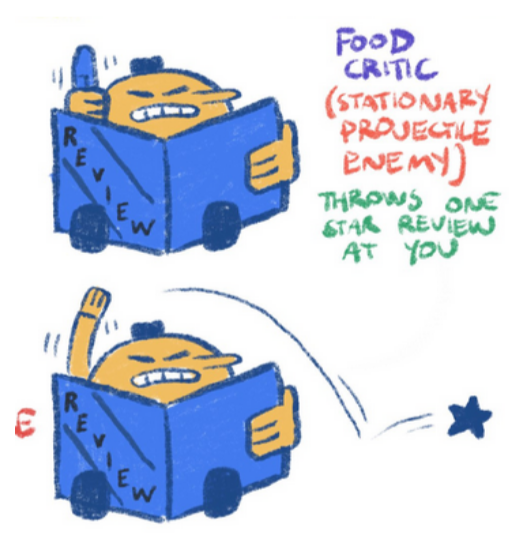
Food Critic Enemy Mock-up by Tommy Dassalo
In other cases, I was free to throw ideas into the game myself. I had been toying with a boss fight concept that involved emojis as the primary attack and Scrolling Skies, a manifestation of Tommy’s late night phone scrolling, was a perfect fit.
In another instance, I asked Tommy if we could put in an “Aroused Eggplant” enemy that when whipped, would get a boner which then becomes a platform that can be used as a platform for a small amount of time (which I later changed to a bouncing obstacle because the boner bounce was too irresistible to put in). To my surprise, Tommy approved and he sent me back a mock-up of an eggplant enemy in his style.
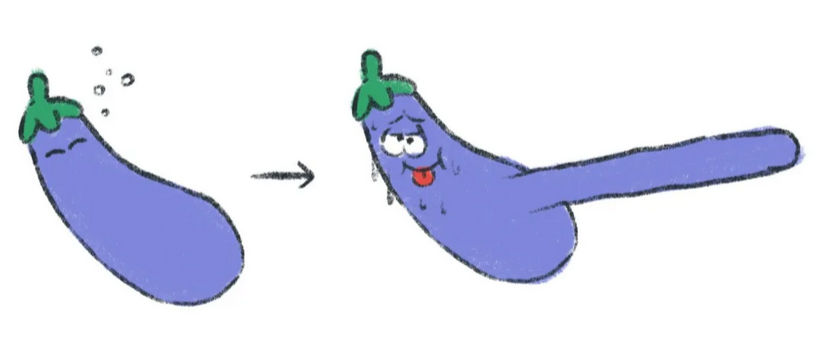
‘Aroused Eggplant’ Enemy Mock-up by Tommy Dassalo

The Aroused Eggplant fully realized in Scrolling Skies 2-2
My favorite character in the game is the rat enemy and a prime example of the collaborative process between Tommy and I. When Tommy presented me with the Blackout HQ mock-up, I saw yellow liquid dripping from the roof and puddles on the floor. The puddles seemed like a great opportunity to introduce some ice-like physics so that Tommy would be slipping in them and provide a little bit more controlled platform difficulty in what would be the last world in the game.

Blackout HQ Mock-up by Tommy Dassalo
My brain went straight to pee puddles rather than spilled beer, so I asked Tommy which of the two it was. He said “well, it could be either.” It inspired me to come up with an enemy that was so drunk, it would be maniacally peeing all over the pub and the player would have to avoid the stream. I thought the reveal of this enemy later on in the world would make for a great moment when the player realizes they have been slipping in pee rather than spilled beer the whole time. So Tommy comes back with a concept illustration of a rat with a beer bottle on his head.
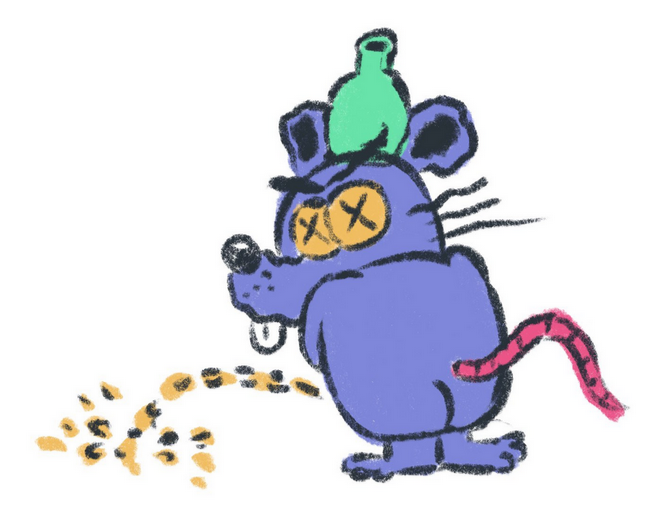
The Rat Enemy Mock-up by Tommy Dassalo
And again, I was given approval to go full frontal nude with the Drunk Rat attack animation because Tommy doesn’t mind taking the joke to that next level.

The Drunk Rat fully realized in Blackout HQ 3-2
So we went from a drawing with spilled beer to a great multi-layered joke and a memorable enemy in the form of a Drunk Rat by playing off each other's ideas. This was typical of the entire process.
It was an absolute pleasure to work with Tommy and create a game that accompanies another piece of self expression outside the world of gaming for a change. Tommy is an independent artist just like myself and released this game for free at great expense. Super Dassalo Land represents a dream of his, to be the art director on a game of his very own. So with all that considered, when I’m having a great time developing the game and making something special, and Tommy is encouraging creative freedom amongst the team, and is welcoming of some of my more controversial ideas such as the Aroused Eggplant or Drunk Rats full frontal nudity, it's so much easier to treat this less like a job, and more like something you are making with your friends just for the fun of it.
I hope you have enjoyed learning about some of the aspects of SDL's development. Thanks to Tommy and the team for making the development of Super Dassalo Land so enjoyable and rewarding. In the future, I will look into doing a follow up devlog and explain how the player move-set of Super Dassalo Land was coded for those interested in improving their GB Studio knowledge.
Happy gaming,
- Tom (Gumpy Function)
Get Super Dassalo Land
Super Dassalo Land
A Platformer Prequel to Tommy Dassalo's 'Scam Artist'
| Status | Released |
| Author | Gumpy Function |
| Genre | Platformer |
| Tags | 8-Bit, Comedy, Funny, Game Boy, Game Boy ROM, gbstudio, Pixel Art |
More posts
- Super Dassalo Land v1.1 UpdateAug 16, 2024
Comments
Log in with itch.io to leave a comment.
I'd love to read up on the more detailed GB Studio parts of the game. I can see that Platform+ was used, how animated tiles, sprites etc were used - but it would be great to get some more in-depth dev logs about the coding and BTS stuff!
For sure, bud. I'll write up an article on the platformer + player move-set 100%
I'd be interested in every aspect - the player, sprites, animations, HUD, score calculations, level setup... dive deep!!! Maybe a series of articles 🤔 😉
Great write up! And cool to see more awesome art made in my own home town. Hopefully you two get a chance to collaborate again in the future.
nice read! I hope you can keep working on cool projects like that!
great read, thanks! I was wondering, since SDL was the first of your games that I played, which others from your back-catalogue would you recommend trying next?
Hey, thanks! If you're into platformers, there is Feed IT Souls and Tomato Face, they are both single session experiences since they are jam games.
If you like puzzles then there is Unearthed. That came out very recently and is a full GB/GBC title. Or there is Dicee! I made Dicee! For my wife as a gift since she can't get enough of yahtzee, so that's recommended if you like the sound of a chill dice game with lots of replayability. There is also In The Dark 2 - although just the demo is available currently.
Then there are my fan games. The simpsons ones are a little experimental but if you're a fan of the Simpsons then absolutely have a go at them. (Speaking of, I am currently creating a new version of Lee Carvallos Putting Challenge 2 in full color this time - so watch our for that).
Cheers